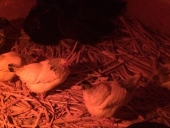posted 11 years ago
You are likely right it is probably more of a problem than it is worth.
Cattails just seem like a nice source of carbohydrates if the water is clean enough.
There are some areas were only cattails grow.
It might make more sense to use sterile grass crap to clear cattails.
I can raise sun chooks, hog nuts, ground nuts, etc. for pigs to rootup elsewhere.
If the pond is large enough it may be practicle to use planting rafts to grow plant that would take nutrients away from cattails.
I have seen some nice greens, peppers, and determinate tomatoes growing on floating beds overseas.
There are alot of vernal pools in my area. Some are overgrown with cattails do to nitrogen in runoff.
It just seems like if the cattails were safe to eat and the area dry enough, pigs could plow the area clean of cattails.
When it is dry the frogs, salamandars, etc. are back in the woods again.
If ponds get low in the summer exposing cattails pigs should be able to feed on them.
If the pond water can drop a bit pig can be sure to get cattails.










